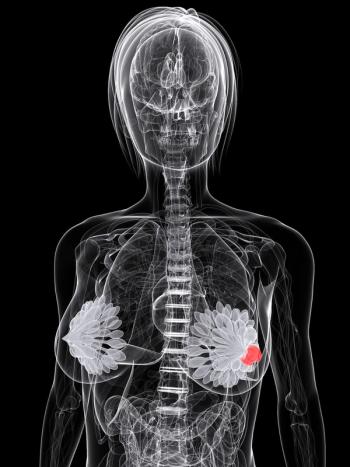
Pancreatic NETs Do Not Experience PFS Boost With Axitinib/Octreotide
No significant benefits to progression-free survival were noted with the axitinib-plus-octreotide combination for the treatment of patients with advanced G1-2 extra-pancreatic neuroendocrine tumors.
Despite showing an acceptable safety profile and moderate antitumor activity, a phase 2/3 trial (NCT01744249) of axitinib (Inlyta) plus octreotide LAR failed to meet the primary end point of statistically significant benefit in progression-free survival (PFS) versus placebo in patients with advanced G1-2 extra-pancreatic neuroendocrine tumors (NETs), according to data presented during the 2021 Gastrointestinal Cancers Symposium.
The median PFS was 17.2 months with axitinib versus 12.3 months with placebo (HR, 0.816; 95% CI, 0.610-1.091; P = .0169).
The study randomized 256 patients to receive axitinib (n = 126) at 5 mg twice a day and octreotide LAR at 30 mg intramuscularly every 4 weeks versus placebo (n = 130) and octreotide LAR at 30 mg intramuscularly every 4 weeks. The primary study end point was PFS and secondary end points included overall response rate (ORR), duration of response (DOR), and overall survival (OS).
Axitinib is a potent and selective VEGFR inhibitor with proven activity against other vascular-dependent solid tumors. Therapeutic options for patients with pancreatic NETs are limited.
Patients could have received 2 prior lines of systemic therapy but no prior antiangiogenic agents. They also need to have an ECOG performance status of 0 to 2. Patients were stratified based on time from diagnosis to study entry (greater than 12 months vs 12 months or less), primary tumor site (gastrointestinal tract vs non-gastrointestinal tract), and Ki-67 index (5% or less vs greater than 5%).
The phase 2 portion of the study (n = 105) used Simon’s randomized design in which the primary end point was an increase of 15% of the PFS rate at 6 months. The data safety monitoring board and trial sponsor decided to extend the study based on phase 2 results, enrolling an additional 148 patients to bring the sample size to 253 patients (105 + 148). The required number of events for final analysis was 151 and included a minimum of 95 events in the extended cohort.
PFS by stratification factors demonstrated a slight trend towards a lower hazard ratio for time from diagnosis to randomization of 12 months or less for axitinib versus placebo (22.68% vs 14.57%; HR, 0.76) and those patients with a 5% or less Ki-67 index (22.68% vs 13.09%; HR, 0.74), according to lead study author, Rocio Garcia-Carbonero, MD.
In subgroup analyses, outcomes overall favored the group who received axitinib. Median PFS for patients in the axitinib arm with grade 1 tumors (30.15 months vs 19.04 months for axitinib and placebo, respectively; HR, 0.51) seemed to indicate greater benefit versus patients with grade 2 tumors (13.51 months vs 11.15 months; HR, 0.86), noted Garcia-Carbonero. In addition, patients with carcinoid syndrome who received axitinib demonstrated a median PFS of 18.54 months compared with 8.4 months for the placebo group (HR, 0.58). Garcia-Carbonero reported a slight benefit in those patients who had no or 1 prior line of therapy and received axitinib.
The best overall response rate was higher in the axitinib arm versus the placebo arm (17.5% vs 3.8%; P = .0004). Sixty-nine percent of patients demonstrated tumor shrinkage in the treatment arm compared with 44% of patients in the placebo arm.
“Patient and disease characteristics were well balanced, except for grade G2 tumors, which was higher in the axitinib arm [69.8%] versus the placebo arm [58.5%],” Garcia-Carbonero, an associate professor at the Hospital Universitario Doce de Octubre in Madrid where she coordinates the Gastrointestinal (GI) Tumor Unit, said during the presentation.
Average median age was 61 years for both arms and the primary tumor sites for the axitinib arm compared with the placebo arm were gastrointestinal (61.1% vs 56.9%), lung (29.4% vs 26.2), unknown primary (6.3% vs 10.0%), and other (3.2% vs 6.9%), respectively. Forty-six percent (46.2%) of patients in the placebo arm reported receiving no primary systemic therapy compared with 43.7% in the axitinib arm.
Common reasons for treatment discontinuations in the treatment arm versus the placebo arm were disease progression (45.2% vs 63.8%), adverse effects ([AEs] 23.8% vs 4.6%), consent withdrawal (4.0% vs 3.1%), and death (3.2% vs 2.3%), respectively.
Overall AEs were consistent with the safety profile of axitinib. Most common all grade AEs observed with the study drug were diarrhea (63.2%), asthenia (52.0%), hypertension (50.4%), and mucositis (28.8%). Grade 3/4 treatment-related AEs occurred more frequently in the axitinib arm compared with the placebo arm (52% vs 14%, respectively). Most common grade 3/4 AEs were hypertension (20.8%) and diarrhea (13.6%). There were 3 treatment-related deaths; these included 1 patient in the axitinib arm due to cardiac failure and 2 in the placebo arm due to myocardial infarction and hepatorenal syndrome.
The combination axitinib and octreotide LAR failed to demonstrate a significant improvement in PFS as compared with placebo and octreotide LAR, but investigators did observe improved response with the treatment as compared with the placebo. Overall, the safety profiles of axitinib and octreotide LAR were consistent with known safety profiles for each drug. Independent blinded radiological assessment of PFS is currently ongoing.
Reference
Garcia RG, Benavent M, Fonseca PJ, et al. A phase II/III randomized double-blind study of octreotide acetate with axitinib versus octreotide acetate with placebo in patients with advanced G1-G2 NETs of non-pancreatic origin (AXINET trial-GETNE-1107). J Clin Oncol. 2021;39(suppl 3); abstr 360.
Newsletter
Stay up to date on recent advances in the multidisciplinary approach to cancer.
















































































